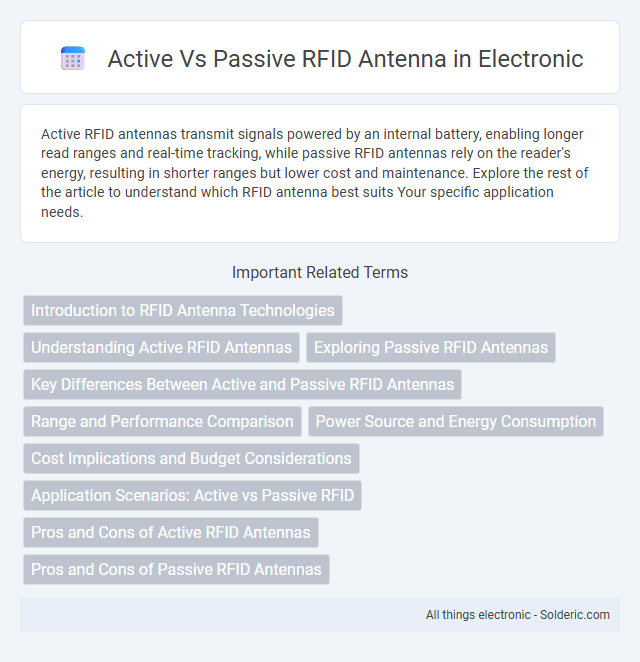Active RFID antennas transmit signals powered by an internal battery, enabling longer read ranges and real-time tracking, while passive RFID antennas rely on the reader's energy, resulting in shorter ranges but lower cost and maintenance. Explore the rest of the article to understand which RFID antenna best suits Your specific application needs.
Comparison Table
| Feature | Active RFID Antenna | Passive RFID Antenna |
|---|---|---|
| Power Source | Internal battery | No battery, powered by reader signal |
| Range | Up to 100 meters or more | Up to 10 meters |
| Signal Strength | Strong, consistent signal | Weaker, varies with distance |
| Cost | Higher cost per tag and antenna | Lower cost, simpler design |
| Size | Larger due to battery and electronics | Smaller, compact |
| Maintenance | Requires battery replacement | Maintenance-free |
| Application | Long-range tracking, asset monitoring | Inventory, access control, short-range tasks |
| Data Storage | Can store more data onboard | Limited data storage |
Introduction to RFID Antenna Technologies
Active RFID antennas utilize powered transmitters to send signals over longer distances, enabling real-time tracking in large-scale asset management systems. Passive RFID antennas rely on energy harvested from the reader's signal, resulting in limited range but cost-effective deployment for inventory control and access verification. Understanding the distinct power requirements and communication capabilities of active versus passive RFID antennas is crucial for optimizing system design and performance.
Understanding Active RFID Antennas
Active RFID antennas are designed to communicate with active RFID tags that contain their own power source, enabling longer read ranges of up to 100 meters or more. These antennas actively transmit signals to power the tags and receive data, making them ideal for tracking high-value assets in large areas. Your choice of an active RFID antenna should consider factors like frequency compatibility, read range, and environmental conditions to optimize system performance.
Exploring Passive RFID Antennas
Passive RFID antennas leverage electromagnetic energy emitted by the reader to power the tag, enabling a compact and cost-effective solution. These antennas are designed to maximize the capture of radio frequency signals within the operational range of up to several meters, typically 1-10 meters. Your choice of a high-gain passive RFID antenna can significantly enhance read accuracy and reliability in inventory management or asset tracking applications.
Key Differences Between Active and Passive RFID Antennas
Active RFID antennas have built-in power sources that enable longer read ranges and stronger signal transmission, making them ideal for tracking high-value assets over greater distances. Passive RFID antennas rely on energy harvested from the reader's signal, resulting in shorter operational ranges but lower cost and maintenance requirements. Your choice between active and passive RFID antennas should consider factors such as range, power availability, and application environment.
Range and Performance Comparison
Active RFID antennas provide longer read ranges, typically up to 100 meters or more, due to their onboard power source that amplifies signal strength. Passive RFID antennas rely solely on the reader's power, resulting in shorter ranges, usually within a few meters, but offer lower cost and maintenance. Your selection depends on required range and performance needs, with active systems excelling in high-range, high-performance applications.
Power Source and Energy Consumption
Active RFID antennas have their own power source, usually batteries, enabling longer read ranges and real-time tracking but require regular maintenance due to energy consumption. Passive RFID antennas rely entirely on energy transmitted from the reader, resulting in lower energy use and maintenance-free operation but limited read distance. Your choice depends on the balance between power availability and the required communication range.
Cost Implications and Budget Considerations
Active RFID antennas typically entail higher upfront costs due to integrated power sources and enhanced signal ranges, making them a significant investment for large-scale or long-distance tracking applications. Passive RFID antennas offer a cost-effective alternative, relying on reader-generated power and often fitting tighter budgets while supporting shorter range uses. Your choice between active and passive RFID antennas will directly impact overall project expenses and should align with the specific coverage and budgetary requirements of your deployment.
Application Scenarios: Active vs Passive RFID
Active RFID antennas are ideal for large-scale asset tracking and real-time location systems in environments such as warehouses, shipping yards, and outdoor settings where long read ranges and continuous monitoring are crucial. Passive RFID antennas suit inventory management, retail checkout, and access control where shorter read ranges and cost efficiency are prioritized. Your choice between active and passive RFID antennas depends on the required read distance, power source availability, and specific application needs.
Pros and Cons of Active RFID Antennas
Active RFID antennas offer extended read ranges up to 300 meters and continuous signal transmission powered by an internal battery, enabling reliable tracking of assets in large areas or challenging environments. The main drawbacks include higher cost, bigger size, and limited battery life requiring regular maintenance or replacement. Your choice to use active RFID antennas benefits situations demanding real-time location data but involves balancing investment with operational needs.
Pros and Cons of Passive RFID Antennas
Passive RFID antennas offer the advantage of being cost-effective and requiring no internal power source, making them ideal for applications with budget constraints and long-term use. However, their limited read range and reliance on the reader's energy can result in weaker signal strength and potential interference issues. Choosing passive RFID antennas for Your system means balancing affordability with range limitations, especially in environments with numerous obstacles.
active vs passive RFID antenna Infographic

 solderic.com
solderic.com